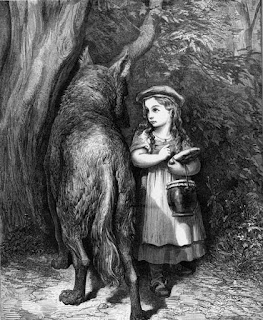Fairy Tale & Gender
After our discussion, let's discuss a little archetype.
Brainstorm your favorite fairy tales. Which fairy tales were your favorite (or are your favorite)? Why do you like this/these stories?
Brainstorm your favorite fairy tales. Which fairy tales were your favorite (or are your favorite)? Why do you like this/these stories?
The Archetypal Fairy Tale
• Stories, often told to children, to entertain, instruct or teach
• Often used to illustrate the problems that children and young people face as they become adults
--What might be some of these typical problems?
--What might be some of these typical problems?
• The characters in fairy tales represent part of our own “psyche” or inner self
Common themes in fairy tales include:
• Metamorphosis• Transformation• Imprisonment• Love• Good versus evil (overcoming obstacles)• Death or transition• Illusion or misunderstanding• Rules or authority
There are often boy and girl fairy tales. These differ in plot.
• Boy fairy tale plots focus on exploration, discovery, and include a climax which separates the boy from his childhood. Usually by the end, the boy has grown into a man.
• Girl fairy tale plots focus on discovery as well, but also abduction, outside threats, powers beyond their control, and falling in love. Usually by the end, the girl has grown into a woman.
Think, Pair, Share: knowing this, apply what you've just learned to the fairy tales you know. What kinds of fairy tales have these been? Were your favorite fairy tales boy or girl fairy tales? Discuss.
Fairy Tale Characters
• Often good, innocent, or sometimes foolish.
• Often instructed by an older person or character (sometimes a mystical creature)
• Often fairy tale characters have to face great odds
• Often fairy tale characters are given an item(s) that allows them to discover who they are
Fairy tale form:
• Usually written in 3rd person point of view with an omniscient narrator
• Usually begins with “Once upon a time…” and ends “happily ever after.”
• Usually include the rule of 3 (the first two times a character tries something, it usually doesn’t work)
Let's take a look at a few poems. The poets Anne Sexton and Carol Ann Duffy have used fairy tales for their own exploration of gender issues. Let's do the same.
Lab Task:
Read this short article: http://www.bbc.com/culture/story/20130801-too-grimm-for-children
Then check out these websites: http://www.pitt.edu/~dash/grimmtales.html
German: The Brother's Grimm
Danish: Hans Christian Andersen
French: Charles Perrault
Let's take a look at a few poems. The poets Anne Sexton and Carol Ann Duffy have used fairy tales for their own exploration of gender issues. Let's do the same.
Lab Task:
Read this short article: http://www.bbc.com/culture/story/20130801-too-grimm-for-children
Then check out these websites: http://www.pitt.edu/~dash/grimmtales.html
German: The Brother's Grimm
Danish: Hans Christian Andersen
French: Charles Perrault
- Choose a fairy tale that you want to work with (consider your favorites--or be unique and consider one that is not as well known)
- Write a narrative or prose poem or a story or scene or an essay in which you explore gender and fairy tale themes.


Comments